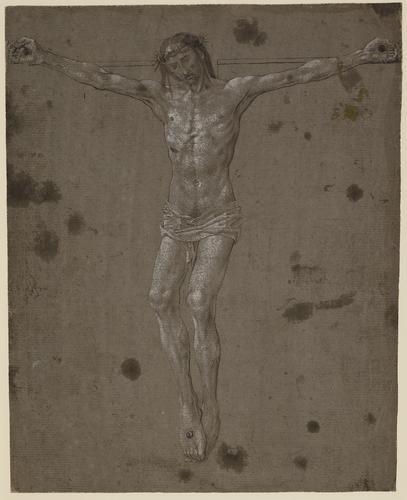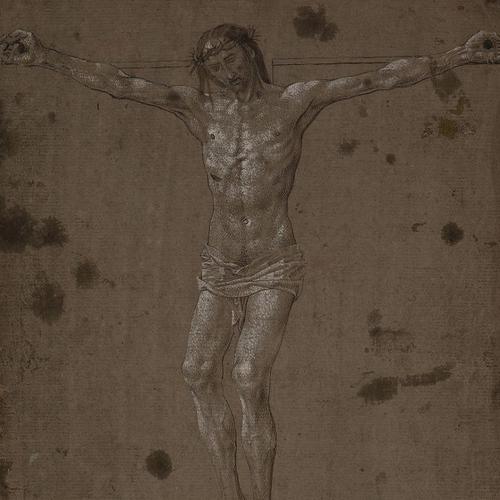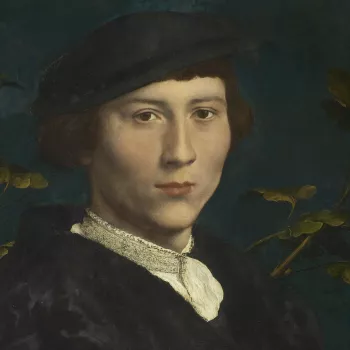Christ on the Cross c.1467-82
Pen and brush and brown ink, heightened with white, on slate-grey prepared paper | 25.8 x 21.0 cm (sheet of paper) | RCIN 912951

Attributed to Hugo van der Goes (c. 1440-1482)
Christ on the Cross c.1467-82


-
The present drawing has been connected with a lost painting of the Crucifixion of which a copy, attributed to a follower of Hugo van der Goes is in the Museo Correr in Venice, although there are some slight differences between the two, notably in the positioning of Christ’s legs. The image of the suffering Christ, while having a practical use for the artist, was also an important emotive element of late medieval devotion. The Imitatio Christi of Thomas à Kempis, a key manual of late medieval spirituality, and almost certainly known to Hugo, urged followers to ‘keep ever before you the likeness of Christ crucified. As you meditate on the life of Jesus Christ, you should grieve that you have not tried more earnestly to conform yourself to Him, although you have been a long while in the way of God.’
Hugo van der Goes was an extremely successful artist, who is recorded as having worked in Ghent from the mid-1460s to the mid-1470s. During this time he undertook a number of civic projects in the city, as well as travelling to Bruges to help prepare the decorations on the occasion of the marriage of Charles the Bold and Margaret of York in 1468. By 1478, however, he was living in the monastery of the Rode Klooster near Brussels, where he had become a lay brother, although he continued to take commissions for paintings until his death. A contemporary at the Rode Klooster described him as having ‘no equal this side of the Alps’, and blamed pressure of work for the nervous breakdown which Hugo suffered shortly before his death. Hugo’s reputation was such that his most famous surviving work was not intended for the Netherlands, but for Florence. This was an altarpiece commissioned by Tommaso Portinari and intended for the hospital of Santa Maria Nuova in the city (now in the Uffizi). Hugo also undertook work for a Scottish patron: an altarpiece for Edward Bonkil of Trinity College, Edinburgh. The wings of this painting survive in the Royal Collection and have been on loan to the National Gallery of Scotland since 1931.
Drawings by Hugo are harder to attribute, however, and no drawings are known certainly to be by his hand. An assessment of his graphic work is based on a large sheet showing Jacob and Rachel, at Christ Church in Oxford, which is generally acknowledged to be by Hugo as it appears to be by the same hand as the underdrawing for the Portinari altarpiece. The present work shows some similarities to the Oxford drawing. Both have contours drawn with a series of careful strokes, occasionally widened where the artist wished to make adjustments, and very meticulous patches of tight cross-hatching, formed of a series of tiny lines. The white heightening is applied differently on the Windsor sheet, though, as subtle modelling produced by stippling with the point of the brush, rather than the cross-hatched lines that are found on the Oxford drawing. Most recently Stephanie Buck (in Kemperdick and Eising, eds, Hugo van der Goes. Between Pain and Bliss) has argued that the Royal Collection drawing is by Hugo himself.
Catalogue entry adapted from The Northern Renaissance. Dürer to Holbein, London 2011Provenance
Possibly included in George III's album of 'the old Italian Masters and many old Flemish ones' (Inv. A, c.1810, p 16); certainly in the Royal Collection by 1877 (Grosvenor Gallery exhibition, no. 813)
-
Creator(s)
-
Medium and techniques
Pen and brush and brown ink, heightened with white, on slate-grey prepared paper
Measurements
25.8 x 21.0 cm (sheet of paper)








